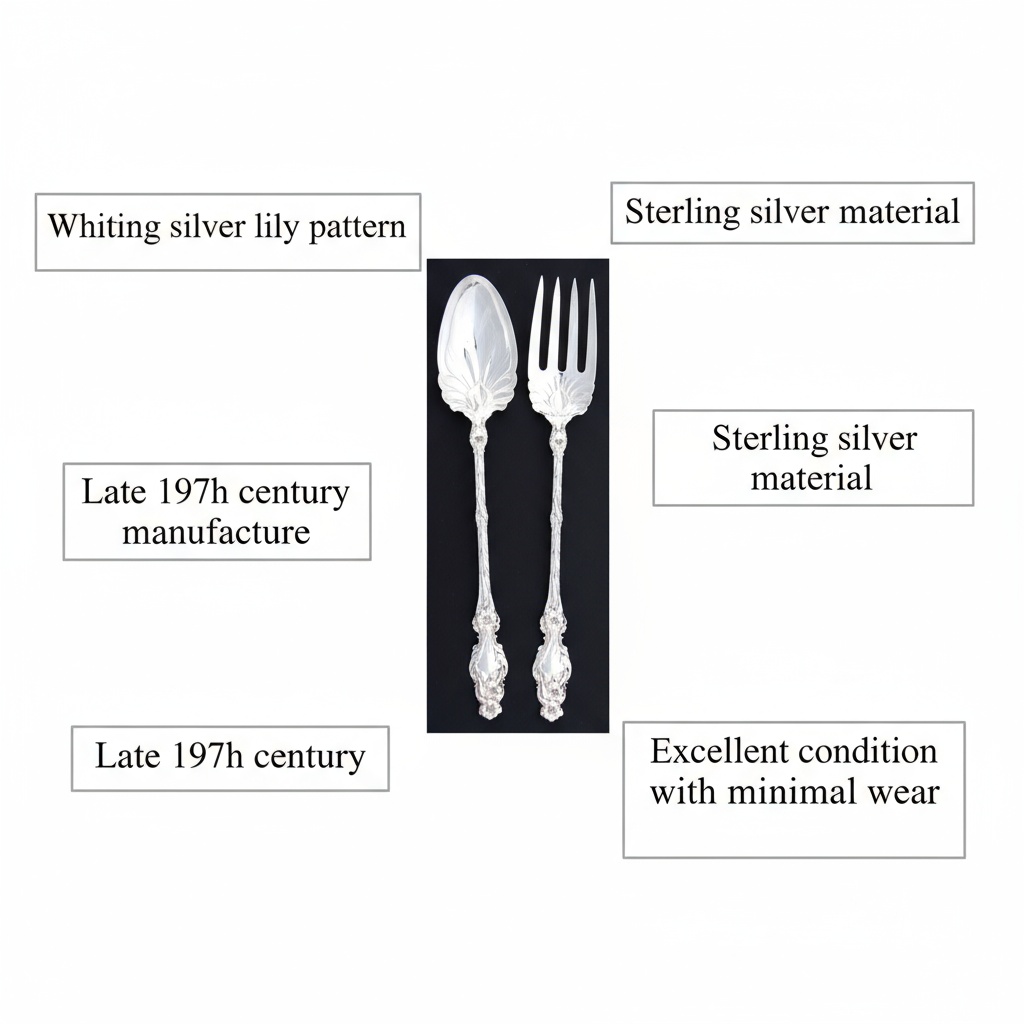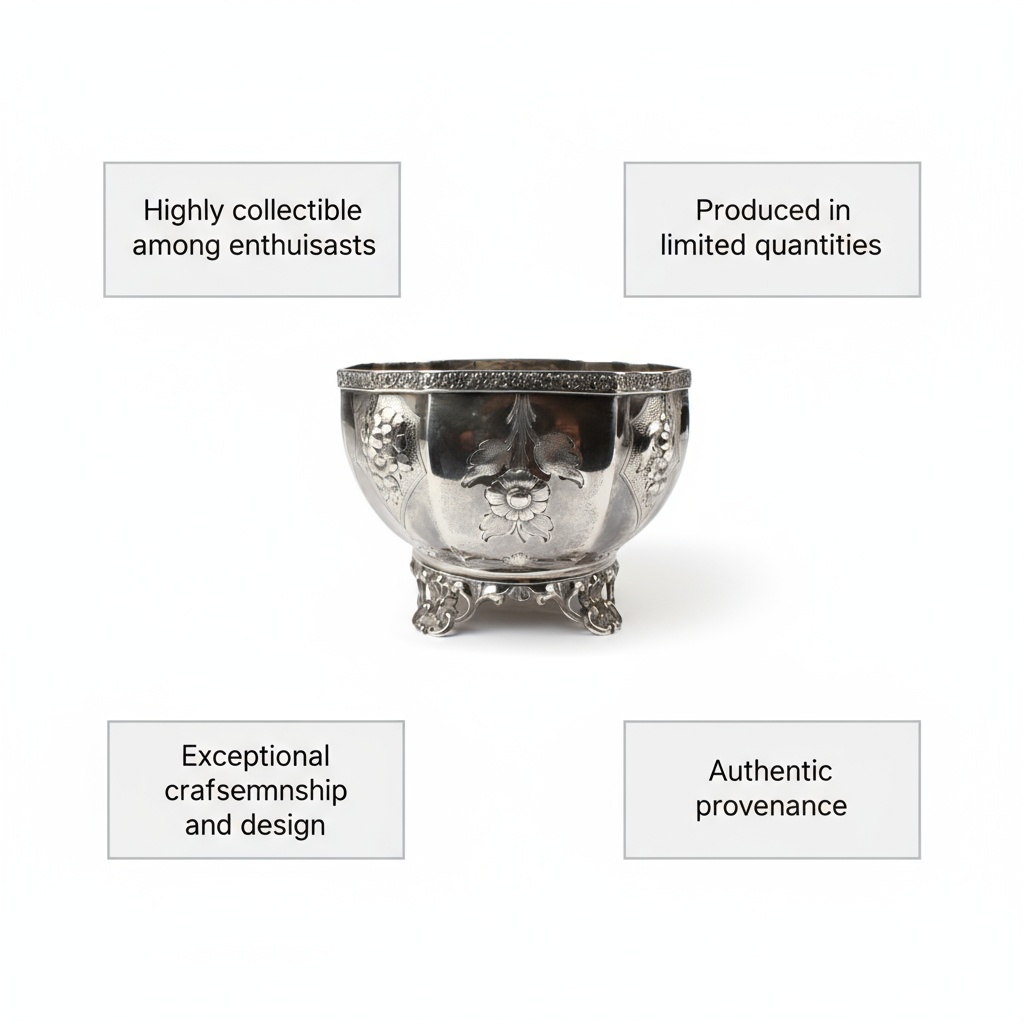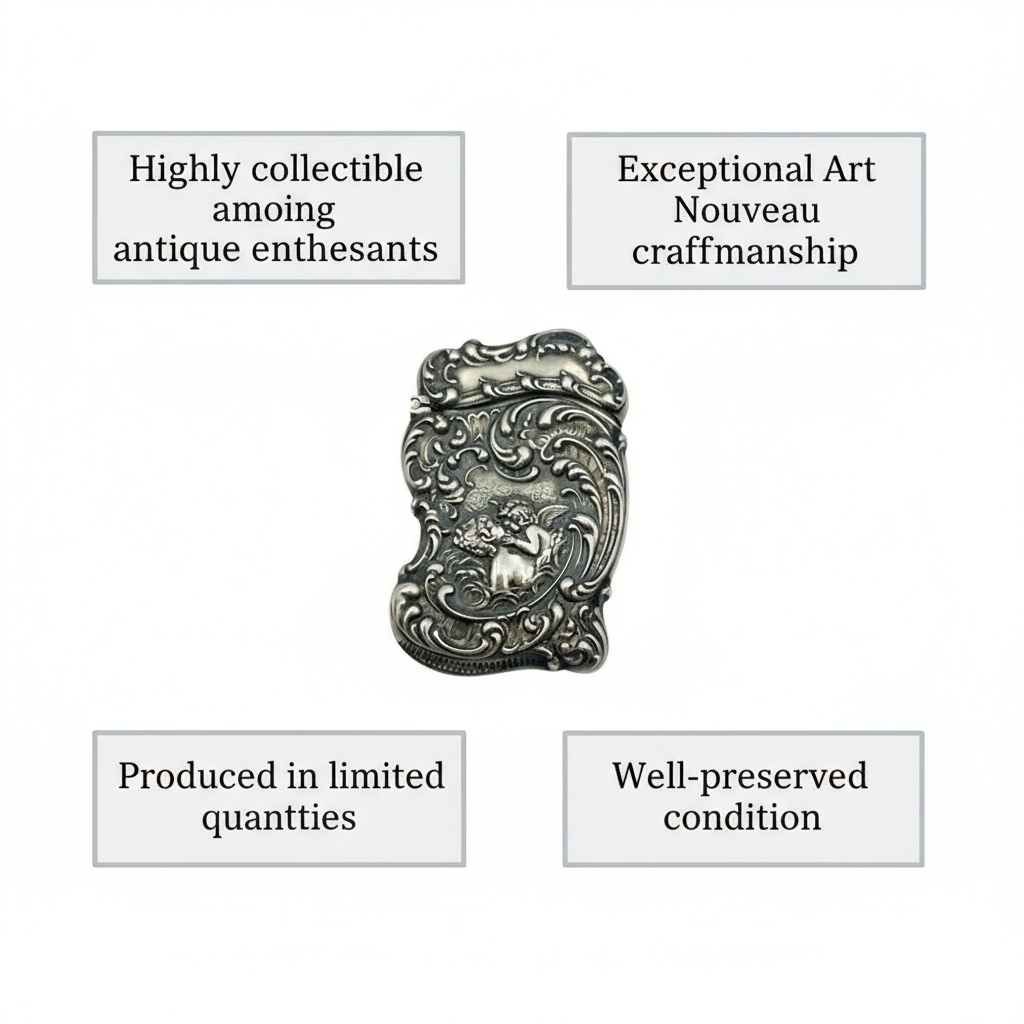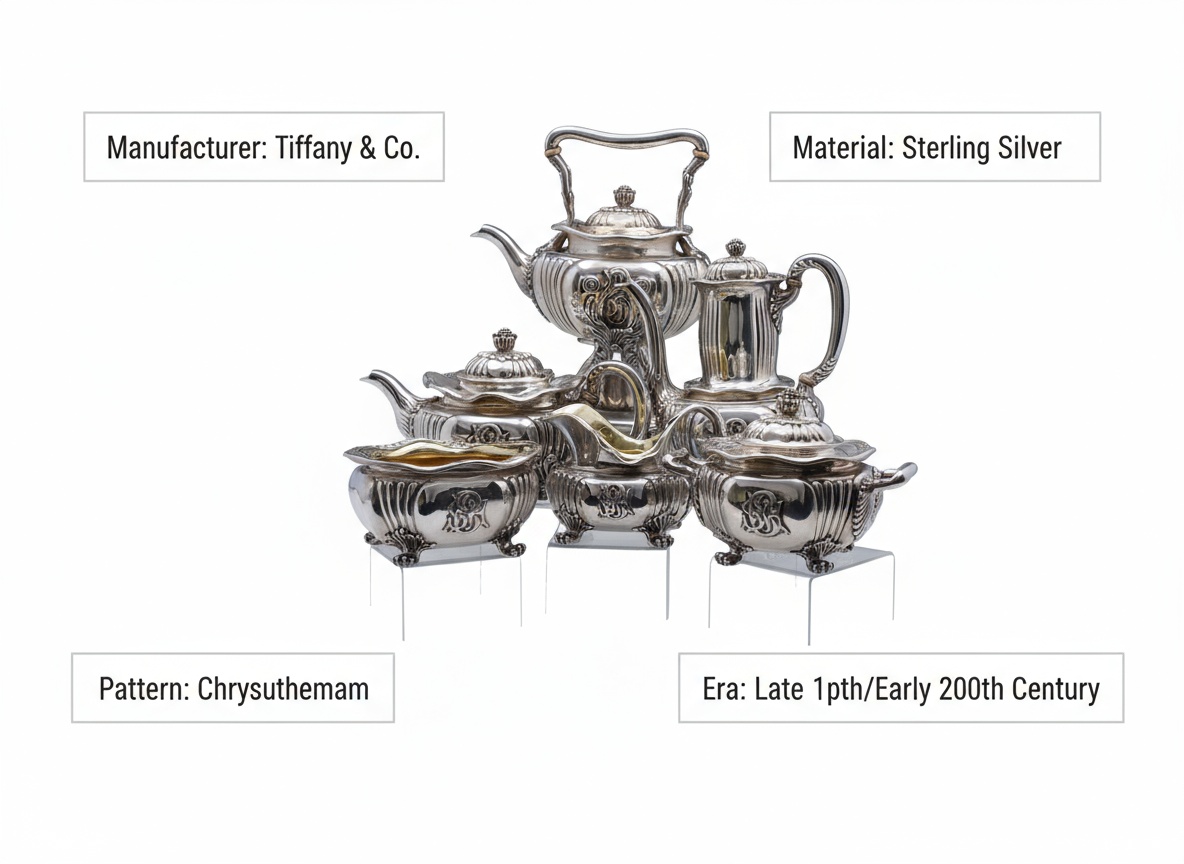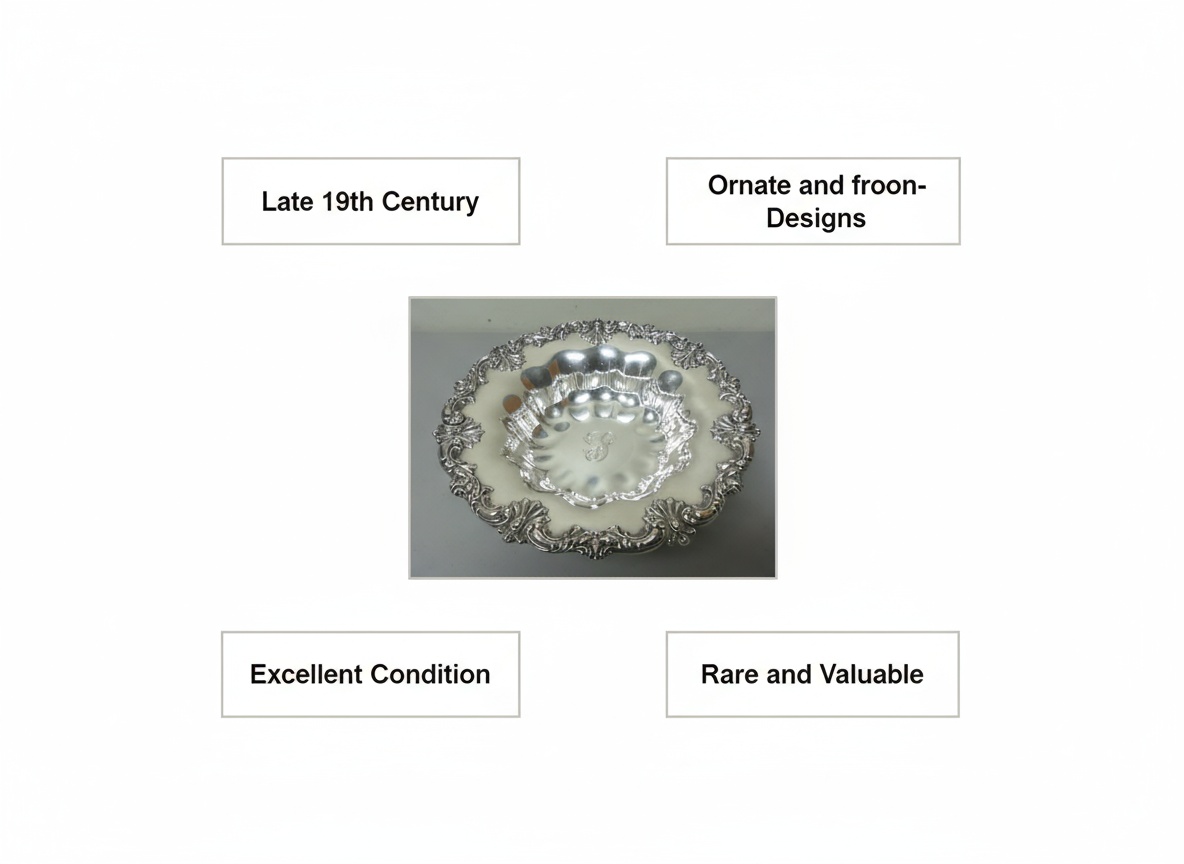<h1>Whiting Silver Lily Pattern Tableware Set: Complete Appraisal Guide</h1>
<h2>Understanding Your Whiting Silver Lily Pattern Collection</h2>
<p>The <strong>Whiting Silver Lily Pattern</strong> represents one of American silverware's most celebrated designs. If you own pieces from this elegant collection, you're holding tableware that reflects exceptional craftsmanship from the late 19th century. But whether you're considering selling, insuring, or simply curious about what your pieces are worth, understanding the factors that determine their value is essential.</p>
<p>The Whiting Manufacturing Company, a prestigious New York-based silversmith, created this iconic pattern with meticulous attention to detail. The delicate lily motifs adorning each piece showcase the artistry and technical skill that defined quality American silverware production during that era. Today, collectors and decorators actively seek out these pieces, making it crucial for you to understand what makes your set valuable.</p>
<div class="callout tip"><p><strong>Pro Tip</strong></p>
<p>Before evaluating your Whiting Lily pattern pieces, examine them closely for maker marks and determine whether they're sterling silver or silver plate—this distinction significantly impacts their worth.</p></div>
<h2>What Determines the Value of Your Whiting Lily Pattern Tableware?</h2>
<p>Your Whiting Silver Lily Pattern set's value depends on several interconnected factors. Understanding each one helps you make informed decisions about appraisal, sale, or insurance.</p>
<h3>Sterling Silver vs. Silver Plate: The Critical Difference</h3>
<p>One of the most important questions you need answered is simple: <strong>Is your Whiting Lily pattern sterling or silver plate?</strong> This distinction alone can mean the difference between hundreds or thousands of dollars.</p>
<p><strong>Sterling silver</strong> contains 92.5% pure silver, making it inherently valuable for both its craftsmanship and material content. Sterling Whiting Lily pieces typically bear marks like "Sterling," ".925," or the Whiting maker's hallmark. These pieces retain their value across decades and appeal to serious collectors.</p>
<p><strong>Silver plate</strong>, conversely, features a thin layer of silver over a base metal. While still beautiful and collectible, silver-plated Whiting Lily items are worth considerably less—often 10-20% of their sterling equivalents. Look for marks such as "EPNS" (Electroplated Nickel Silver) or "Silver Plate" stamped on the underside.</p>
<div class="callout info"><p><strong>Quick Test at Home</strong></p>
<p>Use a magnet on the underside of your pieces. Real silver is non-magnetic, so if the magnet sticks, you're dealing with silver plate over a ferrous base metal. For definitive proof, consult a professional appraiser.</p></div>
<h3>How Condition Impacts Your Set's Market Value</h3>
<p>A Whiting Silver Lily Pattern set in excellent condition with minimal wear commands premium prices. However, condition assessment requires a trained eye.</p>
<p>Look for these condition markers:</p>
<ul>
<li><strong>Minimal wear</strong>: Original polish, maker marks crisp and visible, no dents or repairs</li>
<li><strong>Good condition</strong>: Light patina, some minor surface marks, all pieces functional</li>
<li><strong>Fair condition</strong>: Noticeable wear, possible dents, repairs, or heavy polishing that obscured details</li>
<li><strong>Poor condition</strong>: Significant damage, deep scratches, significant repairs, or missing pieces</li>
</ul>
<p>Heavy polishing is particularly problematic—aggressive cleaning can remove maker marks, compromise the original finish, and actually <em>decrease</em> value rather than increase it. If you're planning to have your pieces appraised or sold, avoid aggressive cleaning. A gentle removal of loose dirt and heavy grime is acceptable, but always inform your appraiser about any cleaning you've done.</p>
<h3>Completeness and Set Configuration</h3>
<p>Are you selling a complete service for twelve? A partial set of serving pieces? Individual place settings? <strong>Completeness directly affects value.</strong> A full set of Whiting Lily pattern flatware with serving pieces, in original condition, commands significantly more than scattered individual pieces.</p>
<p>Keep original storage cases or documentation if you have them—these add provenance and can enhance value by 10-25%.</p>
<h2>How Much Is Your Whiting Silver Lily Pattern Worth Today?</h2>
<p>Pricing your Whiting Silver Lily Pattern pieces requires research into current market conditions. A complete sterling silver service set typically ranges from $4,000 to $6,000, depending on the factors we've discussed. However, individual pieces or silver-plated items may be valued at $50 to $300 each.</p>
<h3>Finding Comparable Sales</h3>
<p><strong>How do I find the current market value for a Whiting Lily pattern flatware set?</strong> Start by researching completed auction listings and marketplace sales for "Whiting Lily" or similar pattern names. Compare items by material, number of pieces, and condition. Sites specializing in antique silver and major auction houses frequently list comparable sales, giving you real-world pricing data.</p>
<p>When evaluating comparable sales, ensure you're comparing apples to apples:
- Same material (sterling vs. plate)
- Similar condition
- Matching piece count
- Recent sales (within the last 6-12 months)</p>
<p>For a conclusive and defensible valuation, however, <strong>get a written appraisal from a credentialed appraiser</strong> who follows USPAP standards. This becomes essential if you're planning to sell, insure, or settle an estate. Learn more about what to expect in our guide on <a href="/blog/appraisals-for-fine-silver-and-flatware-valuing-exquisite-tableware">appraising fine silver and flatware</a>.</p>
<div class="callout info"><p><strong>Market Insights</strong></p>
<p>Sterling silver values fluctuate with metal prices and collector demand. Checking recent auction results gives you a snapshot of current market appetite for Whiting Lily pieces specifically.</p></div>
<h2>Authenticating and Testing Your Pieces</h2>
<p>Before you commit to selling or insuring your Whiting Lily pattern collection, you need confidence in its authenticity and material composition.</p>
<h3>How Can You Tell If Your Lily Pattern Is Sterling or Silver Plated?</h3>
<p><strong>Look for maker marks first.</strong> Turn over each piece and examine the underside carefully. Sterling Whiting pieces display "Sterling," ".925," or a Whiting maker mark—often a "W" with distinctive styling. Silver-plate items typically show "EPNS," "A1," or "Silver Plate."</p>
<p><strong>The magnet test</strong> is your quickest non-destructive verification method. Pure silver is not magnetic; if a magnet adheres to your pieces, you're dealing with silver plate over a base metal core.</p>
<p><strong>Inspect for wear-through</strong> on high-use areas like fork tines or spoon bowls. If you see base metal showing through worn spots, that's silver plate. Sterling silver won't expose a different metal underneath.</p>
<h3>Can You Test Whiting Lily Silver at Home to Estimate Value?</h3>
<p>You can perform basic authentication at home, but avoid potentially damaging tests. <strong>Never use acid tests or scratch the surface</strong>—these methods can damage your pieces and reduce their value.</p>
<p>Safe home tests include:
1. Visual inspection for hallmarks and maker stamps
2. The magnet test (non-destructive)
3. Inspecting high-wear areas for base-metal showing through
4. Checking the weight and feel (sterling is denser than plate)</p>
<p>For reliable professional testing and detailed valuation, consult an appraiser who can examine your pieces without risk. If you're selling valuable sterling pieces or need formal documentation for insurance, a professional appraisal is worth the investment. Explore our resource on <a href="/blog/a-guide-to-identifying-the-best-antique-silver-appraisers">identifying the best antique silver appraisers</a> to find qualified professionals.</p>
<h2>Making the Decision: Selling, Insuring, or Keeping Your Collection</h2>
<p>Once you understand your Whiting Silver Lily Pattern's value and authenticity, you face a decision: keep it, insure it, or sell it.</p>
<h3>Should You Sell Through a Pawn Shop?</h3>
<p><strong>Is it worth selling Whiting Lily silver at a pawn shop?</strong> Typically, no—not if you want fair market value. Pawn shops often offer scrap or wholesale prices, especially for silver plate. Even for sterling pieces, you'll usually receive 40-60% of market value.</p>
<p>If your Whiting Lily items are sterling and in good condition—or part of a complete set—you'll receive substantially more from:
- <strong>Specialty silver dealers</strong>: They understand the collector market and can price accordingly
- <strong>Auction houses</strong>: Ideal for rare sets or complete services for 12
- <strong>Online marketplaces for collectors</strong>: Targeted platforms attract buyers willing to pay premium prices
- <strong>Local antique shops</strong>: Good for common silverplate or single pieces</p>
<h3>Where Should You Sell Your Whiting Lily Pattern for the Best Price?</h3>
<p>The best sales channel depends on what you're selling:</p>
<ul>
<li><strong>Complete sterling services for 12</strong>: Consider reputable auction houses or consignment with a specialty dealer</li>
<li><strong>Partial sets or serving pieces</strong>: Online antique marketplaces or local dealers</li>
<li><strong>Common silverplate</strong>: Online listings on collector platforms or local antique shops</li>
<li><strong>Individual decorative pieces</strong>: Estate sale companies or online marketplace listings</li>
</ul>
<p>Explore our internal resource on <a href="/types/antique-silver">antique silver appraisals</a> to understand the full range of services available.</p>
<h3>Should You Clean Your Whiting Lily Silver Before Getting an Appraisal or Selling?</h3>
<p><strong>Should I clean my Whiting Lily silver before getting an appraisal or selling it?</strong> Light cleaning is fine; aggressive polishing is not.</p>
<p>Remove heavy grime and loose dirt gently. For photos intended for sale or appraisal, a gently cleaned piece looks more appealing. However, <strong>always inform your appraiser about any cleaning you've performed</strong>. Original patina and finish can actually add value to rare pieces, and over-polishing can remove critical maker marks or compromise the piece's authenticity assessment.</p>
<p>When in doubt, ask your appraiser before cleaning. They can advise you on the best approach without damaging your collection.</p>
<div class="callout warning"><p><strong>Important</strong></p>
<p>Never use commercial silver polish or abrasive materials on valuable antique pieces. If unsure about cleaning methods, consult a professional first.</p></div>
<h2>The Value of Professional Appraisal for Your Whiting Collection</h2>
<p>Whether you're planning to sell, insure, or simply want to know what you own, a professional appraisal provides definitive value assessment backed by expertise and market knowledge.</p>
<p><strong>USPAP-compliant appraisals</strong> follow the Uniform Standards of Professional Appraisal Practice, ensuring your valuation is ethically sound, thoroughly documented, and legally defensible. This matters whether you're:
- Settling an estate
- Filing an insurance claim
- Preparing for a sale
- Establishing tax basis for donations
- Managing a trust or inheritance</p>
<p>Credentialed appraisers certified by organizations like the <strong>International Society of Appraisers (ISA)</strong> or <strong>American Society of Appraisers (ASA)</strong> understand the nuances of antique silverware valuation—from material composition to historical significance to current collector demand. They bring expertise that generic online valuation tools simply cannot match.</p>
<p>Learn more about the process in our comprehensive guide: <a href="/blog/everything-you-need-to-know-about-antique-silver-appraisal">everything you need to know about antique silver appraisals</a>.</p>
<h3>Is Now a Good Time to Sell Sterling Silver Flatware?</h3>
<p><strong>Is now a good time to sell sterling silver flatware?</strong> Market timing matters. Sterling silver values fluctuate based on precious metal prices, collector interest, and economic conditions. If you've been holding onto your Whiting Lily pattern for years, consulting current market data and recent comparable sales gives you confidence in timing.</p>
<p>A professional appraiser can contextualize current market conditions and help you understand whether today's market favors sellers or buyers. They can also advise on alternative strategies if immediate sale isn't optimal.</p>
<h2>Understanding What Makes Whiting Lily Pattern Special</h2>
<p>Whiting Manufacturing Company earned its reputation through decades of exceptional silversmithing. The Lily pattern represents their design philosophy: elegance achieved through meticulous craftsmanship and refined aesthetics.</p>
<p>Late 19th-century Whiting pieces stand out for their:
- <strong>Intricate design work</strong>: The lily motifs require skilled artisans to execute properly
- <strong>Superior material quality</strong>: Whiting sourced excellent sterling silver
- <strong>Historical significance</strong>: These pieces represent an important chapter in American decorative arts
- <strong>Rarity</strong>: Not all patterns were produced in large quantities, making certain configurations genuinely scarce</p>
<p>If you own Whiting Lily pattern pieces, you're holding a tangible piece of American silversmithing history. This historical and artistic significance is reflected in their current market value and collector demand.</p>
<div class="callout note"><p><strong>Key Takeaway</strong></p>
<p>Getting a professional appraisal helps you make informed decisions backed by certified experts who understand market value, authentication, and historical significance of your Whiting Silver Lily Pattern collection.</p></div>

